Related Research Articles
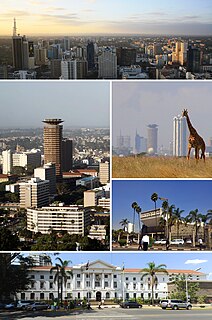
Nairobi is the capital and largest city of Kenya. The name is derived from the Maasai phrase Enkare Nairobi, which translates to "place of cool waters", a reference to the Nairobi River which flows through the city. The city proper had a population of 4,397,073 in the 2019 census, while the metropolitan area has a population of 9,354,580. The city is commonly referred to as the Green City in the Sun.

A slum is a highly populated urban residential area consisting of densely packed housing units of weak build quality and often associated with poverty. The infrastructure in slums is often deteriorated or incomplete, and they are primarily inhabited by impoverished people. Although slums are usually located in urban areas, in some countries they can be located in suburban areas where housing quality is low and living conditions are poor. While slums differ in size and other characteristics, most lack reliable sanitation services, supply of clean water, reliable electricity, law enforcement, and other basic services. Slum residences vary from shanty houses to professionally built dwellings which, because of poor-quality construction or lack of basic maintenance, have deteriorated.
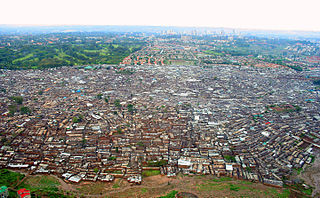
Kibera is a division of Nairobi Area, Kenya, and neighbourhood of the city of Nairobi, 6.6 kilometres (4.1 mi) from the city centre. Kibera is the largest slum in Nairobi, and the largest urban slum in Africa. The 2009 Kenya Population and Housing Census reports Kibera's population as 170,070, contrary to previous estimates of one or two million people. Other sources suggest the total Kibera population may be 500,000 to well over 1,000,000 depending on which slums are included in defining Kibera.

Kisumu County is one of 47 counties in the Republic of Kenya. Its borders follow those of the original Kisumu District, one of the former administrative districts of the former Nyanza Province in western Kenya. Its headquarters is Kisumu City which is the third largest city in Kenya after the capital Nairobi and the coastal city of Mombasa. It has a population of 1,155,574. The land area of Kisumu County totals 2085.9 km2.

Ruiru is a town and municipality in Kiambu County. It sits within the greater Nairobi Metropolitan region. According to the 2019 national population census, Ruiru is the 4th largest urban center in Kenya by population. The name Ruiru is of the Kikuyu dialect and possibly relates to the black cotton soil that is found in most parts of Ruiru to the East and South.

Tropical diseases, especially malaria and tuberculosis, have long been a public health problem in Kenya. In recent years, infection with the human immunodeficiency virus (HIV), which causes acquired immune deficiency syndrome (AIDS), also has become a severe problem. Estimates of the incidence of infection differ widely.

Korogocho is one of the largest slum neighbourhoods of Nairobi, Kenya. Home to 150,000 to 200,000 people pressed into 1.5 square kilometres, northeast of the city centre, Korogocho was founded as a shanty town on the then outskirts of the city.
Amici del Mondo World Friends Onlus is an independent Italian non-profit association of social utility for international cooperationWorld Friends is a Non-Governmental Organization recognized by the Italian Ministry of Foreign Affairs by Law no. 125 of 2014 updated to July 16, 2016, registered in the register of ONLUS and the Register of Legal Persons D.P.R. 361. Recognized by the Government of Kenya as a Non-governmental organization (NGO), in 2011 obtained the same accreditation at the Italian Ministry of Foreign Affairs. Established in 2001, the association has its head offices in Rome and has volunteer-based regional offices in Piedmont, Liguria, Lombardy, Friuli-Venezia Giulia, Veneto, Emilia-Romagna, Lazio, Sicily. The association's African office is based in Nairobi.
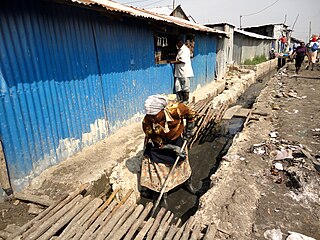
Mukuru Kwa Njenga is a slum in the East of Nairobi. It borders the Jomo Kenyatta International Airport to the north, Industrial Area business district to the south and other growing suburbs areas within Embakasi area such as Donholm Estate. Most of the slums's electorally belongs to Embakasi South Constituency, but it extends into Makadara and Starehe constituencies. It is one of the largest slums in Nairobi. It stretches along the Nairobi–Ngong River, situated on waste lands in the industrial area of the city between the Outering Ring Road, North Airport Road and Mombasa Road.
Lunga Lunga is a settlement and Sub-County in Kenya's Kwale County. It is situated just six kilometers from Kenya's border with Tanzania.
Kisumu Ndogo is a name given to "villages" that are part of two informal settlements in Nairobi, Kenya, Kibera and Korogocho. Kisumu Ndogo means little Kisumu.
First Community Bank (FCB), is a commercial bank in Kenya, the largest economy in the East African Community. It is licensed by the Central Bank of Kenya, the central bank and national banking regulator.
The 2011 Nairobi pipeline fire was caused by an explosion secondary to a fuel spill in the Kenyan capital Nairobi on 12 September 2011. Approximately 100 people were killed in the fire and at least 116 others were hospitalized with varying degrees of burns. The incident was not the first such pipeline accident in Kenya, with the Molo fire of 2009 resulting in at least 133 fatalities and hundreds more injured.
Community Cooker Foundation is an initiative by Planning Systems Services Ltd. in Nairobi, Kenya, established in 2010, with the goal of using the Community Cooker, a simple stove designed to turn rubbish into safe, clean and cheap energy, to transform Nairobi's largest slum, Kibera.
The following is a timeline of the history of the city of Nairobi, Kenya.

Great Lakes University of Kisumu is a Kenyan private chartered university. The idea of establishing the Great Lakes University of Kisumu originated in the Tropical Institute of Community Health and Development (TICH) in Africa, which spearheaded the application for authority to operate as a university. The establishment of TICH in 1998 was inspired by a number of sources expressing the need for a formal course in Community Based Health Care leading to a recognized academic qualification.
The COVID-19 pandemic in Kenya is part of the worldwide pandemic of coronavirus disease 2019 caused by severe acute respiratory syndrome coronavirus 2. The virus was confirmed to have reached Kenya on 12 March 2020, with the initial cases reported in the capital city Nairobi and in the coastal area Mombasa.
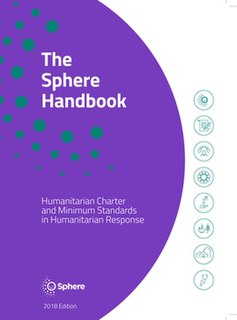
The Sphere Handbook: Humanitarian Charter and Minimum Standards in Humanitarian Response often called the Sphere Standards is a textbook of minimum standards in humanitarian aid published by the Sphere Association.
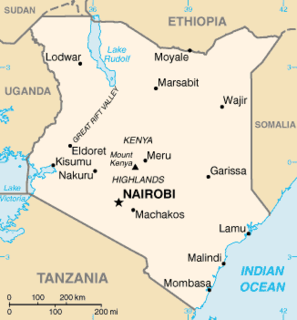
Squatting in Kenya is the occupation of unused land or derelict buildings without the permission of the owner. During colonial occupation, indigenous peoples working on farms owned by white settlers were known as "squatters". As of 1945, there were over 200,000 of these licensed squatters in the Highlands and more than half were Kikuyu. The Mau Mau rebellion began amongst squatters in the late 1940s and after independence in the early 1960s, peasants started squatting land in rural areas.
References
- ↑ "Nairobi County | County Trak Kenya" . Retrieved 2020-08-29.
- 1 2 "Nourishing livelihoods: recognising and supporting food vendors in Nairobi's informal settlements". Human Settlements Working Paper. January 2016.
- ↑ Admin, APHRC. "Nairobi Urban Health and Demographic Surveillance System (NUHDSS)". APHRC. Retrieved 2020-08-16.
- ↑ "Publications". APHRC. Retrieved 2020-08-16.